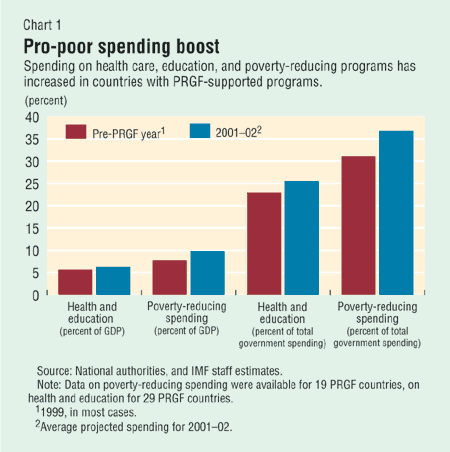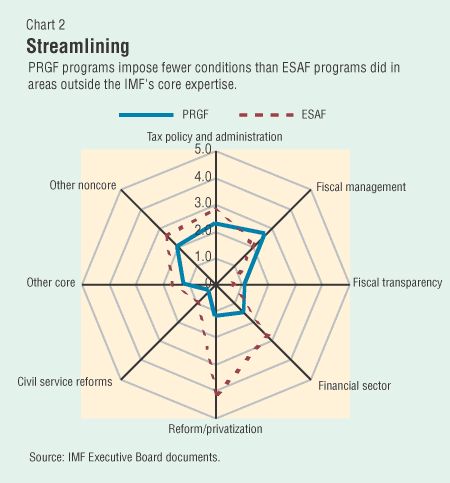 About F&D Subscribe Back Issues Write Us Copyright Information Free Email Notification Receive emails when we post new
items of interest to you. |
Is the PRGF Living Up to Expectations? Sanjeev Gupta, Mark Plant, Thomas Dorsey, and Benedict Clements When the IMF launched the Poverty Reduction and Growth Facility (PRGF) in 1999, it envisaged some far-reaching changes in its operations. First, there would be a change in the content of IMF-supported programs in low-income countries to emphasize pro-poor and pro-growth policies, fiscal flexibility, and better economic governance. IMF conditions for lending, known as "conditionality," would be limited to measures central to the success of the borrowers' strategies and to the areas of the IMF's core expertise. Second, country ownership of programs would be encouraged by basing them on national poverty reduction strategy papers (PRSPs) (see "Taking Stock of Poverty Reduction Efforts" in this issue). Third, the IMF's role and its relationship with other agencies would be better defined and coordinated to ensure that PRGF programs were consistent with the countries' overall poverty reduction strategies and complementary to other institutions' activities. All of this would be done through new design elements in the PRGF that would improve on the IMF's concessional loan facility at the time, the Enhanced Structural Adjustment Facility (ESAF). As it has turned out, demand for PRGF resources has been high. New commitments climbed to $2.7 billion in 2001 from $1.0 billion in 2000. In 2002, the projected loan volume is expected to be somewhat less—$2 billion—but it is still very large, reflecting, in part, the aftermath of the global economic downturn of the past few months. More than 40 countries have had new PRGF arrangements or had ESAF arrangements transformed to include the new features of the PRGF. But is this new facility living up to expectations? To answer this question, the IMF undertook a major review, drawing on a broad range of internal and external views gathered between July 2001 and February 2002. These included a survey of key officials in PRGF countries, as well as those of a wide range of participants (including country officials) in regional meetings on the PRSP approach and the January 2002 International Conference on National Poverty Reduction Strategies organized by the IMF and the World Bank. The focal point of the study was 35 requests for loans under the PRGF considered by the IMF's Executive Board between July 1, 2000, and September 30, 2001. The sample included 19 countries with new, three-year PRGF programs, while 16 countries had transformed ESAF programs into PRGF programs. Given that the PRGF is only a few years old and PRGF Arrangements run three years, the review was necessarily limited in scope, focusing primarily on program design. It is too early to assess whether PRGF programs are achieving their goals for poverty reduction and growth; this will have to wait for another review, which is slated for the spring of 2005. Indeed, in most cases, it is even too early to gauge the success of policy implementation. Moreover, the poverty reduction strategies themselves are still in their infancy. By October 2001, only six countries had PRGF-supported programs supported by a full PRSP; other countries had prepared only an interim PRSP—a preliminary document that, unlike a full PRSP, does not necessarily contain a widely discussed or fully articulated set of macroeconomic and structural policies. Major findings How did the PRGF measure up against the promised key features? Pro-poor, pro-growth public spending. The review found that the composition of budgeted and actual public spending is becoming more pro-poor and pro-growth. Countries with PRGF-supported programs are allocating more, as a percentage of GDP and as a share of total government spending, to education and health care (Chart 1, next page). Real spending per capita on education and health care is projected to rise by more than 10 percent a year over the next few years. Increases of more than 2 percentage points of GDP in outlays identified as poverty-reducing in PRSPs are also envisaged, including outlays for rural development and road construction as well as for primary health care and primary education.  Similarly, more than three-fourths of the PRGF programs incorporate measures to improve efficiency or targeting, such as budgeting a larger share of spending for nonwage inputs and allocating a larger share of social spending for primary health care and primary education, to help countries meet international targets for immunizing their populations, lowering infant mortality, providing health care to pregnant women and the elderly, and improving access to primary school. These larger and better-targeted outlays and the shift toward capital expenditures should contribute to higher growth (and hence poverty reduction) over time. The programs are also attempting to foster growth through the promotion of more efficient tax systems. About three-fourths of them promote efficiency and equity by removing exemptions and broadening the tax base. Greater fiscal flexibility. Fiscal flexibility can be judged from a number of angles. One way is to assess whether the fiscal framework permits an increase in poverty-reducing spending when additional resources are available. When viewed from this perspective, PRGF-supported programs are flexible. They target noninterest public spending that is 2 percentage points of GDP higher, on average, than that targeted under the preceding ESAF-supported programs (see table). This increase in spending has been made possible by larger grants and revenues, which, combined with lower interest burdens, should allow these countries to achieve roughly the same budget deficits targeted under the ESAF. Fiscal flexibility is reflected in other aspects of program design. For instance, countries that have already narrowed their budget deficits and achieved low inflation aim for larger increases in both public expenditure and budget deficits to support their poverty reduction strategies. Also, PRGF programs show greater flexibility in accommodating more spending when foreign financing (including grants) is greater than expected. Two-thirds of them allow financing from domestic sources to compensate—usually partially—for shortfalls in foreign financing.
Better public expenditure management. Almost all PRGF programs emphasize strengthening governance through improved public expenditure management. Each PRGF program request or review includes, on average, four or five new measures to do this—about one-third more than a typical ESAF program—and more than half of these measures are part of the IMF's conditionality. Most focus on keeping expenditures within the limits set in the budget, while others are designed to strengthen auditing procedures or anti-corruption measures. Related to this, PRGF countries—particularly those eligible for debt relief under the Heavily Indebted Poor Countries Initiative—are striving to better track and report poverty-reducing spending by improving budget classification in the medium term and setting up "bridging mechanisms" to do this in the short term. Links to poverty reduction strategies. The broad macroeconomic goals of PRGF programs are essentially identical to those underpinning the interim and full PRSPs in more than three-fourths of the PRGF programs in the sample, and the specific macroeconomic assumptions and projections in PRGF-supported programs are identical to those in two-thirds of the contemporaneous interim and full PRSPs and very similar in the remaining third. Three-fifths of the country authorities responding to the PRGF survey said that, with the PRGF, they had more opportunity to influence program design than in the past and that IMF resident representatives and Washington staff were increasingly engaged in the national dialogue associated with the PRSP process. More selective structural conditionality. The review found that conditionality was substantially streamlined in PRGF programs, in line with expectations for the PRGF and subsequent initiatives for streamlining structural conditionality in all IMF arrangements. Overall, there were about one-third fewer "structural" conditions (performance criteria, prior actions, and structural benchmarks) in PRGF programs than there had been in ESAF programs for the same countries. The number of conditions in core areas of IMF expertise (for example, monetary, fiscal, and exchange regime policies) was almost unchanged, while conditions in areas generally regarded as outside the IMF's expertise (such as privatization and civil service reform) decreased by roughly 60 percent, consistent with the requirement that such noncore conditions be confined to measures critical to the success of the program (Chart 2).

Most PRGF country officials reported greater flexibility on the part of IMF staff on policy choices, more focused and streamlined structural conditionality, and better coordination between the staffs of the IMF and the World Bank, although this is not often highlighted in PRGF staff reports or other PRGF-related documents. This omission may reflect some tension between the need to maintain frank discussions between country officials and IMF staff and the need to demonstrate policy flexibility by articulating the options and trade-offs involved in policy choices. Poverty and social impact analysis. About one-half of the PRGF programs refer to some form of poverty and social impact analysis (PSIA), and about one-third refer to formal PSIAs based on more rigorous analysis (see box, next page). In some cases, a PSIA has resulted in the modification of policies because of concerns about their effect on the poor. About two-thirds of PRGF programs include measures designed to offset the potentially adverse short-term effect of external shocks or macroeconomic or structural reforms on the poor. Nonetheless, countervailing measures are not always accompanied by a PSIA, and, even when they are, the scope and depth of the analysis varies considerably across programs. Most notably, the majority of policies with important social impacts are covered neither by PSIAs nor by countervailing measures. The way forward All in all, PRGF programs have had a promising beginning. Their design seems, in most cases, to be in line with initial goals. But the review found that there is scope for a more systematic application of best practices, especially where there are gaps or progress is uneven.
Moving beyond the assessment of the design of PRGF programs against their initial goals, the review also pinpointed other areas for improvement. First, an increased focus on the sources of growth in PRGF-supported programs is particularly important. Growth is critical for achieving poverty reduction, and attention to the sources of growth is essential in developing appropriate policies and projections. Real growth-rate targets in PRGF-supported programs are higher and growth rises faster, on average, than was the case with ESAF-supported programs. To underpin these targets, PRGF-supported programs should incorporate structural reforms that will enable countries to develop the private sector, increase foreign direct investment, enhance external competitiveness, and increase labor productivity, where these are critical to the programs' success. Second, there is scope for more extensive and effective communication with government officials, development partners, and civil society in countries with PRGF-supported programs. Staff reports should note these communications, and IMF staff need to take the initiative in explaining to the general public their views on, and analyses of, the links between the macroeconomic framework and growth and poverty reduction. Member countries with PRGFs are increasingly taking advantage of procedures for greater transparency; all PRSPs and interim PRSPs, almost all joint assessments of PRSPs by the IMF and Bank staffs, and letters of intent for PRGF-supported programs were published in 2001, as well as roughly half of PRGF IMF staff reports.
Third, documents for PRGF-supported programs should routinely provide a description of the PSIA being carried out, including a qualitative description of the likely impact of major macroeconomic and structural measures on the poor and a summary of countervailing measures taken to offset any adverse effects. They should also include analyses by the World Bank and other donors on topics outside the IMF's areas of expertise. Fourth, there is a need for further capacity building to develop and assess macroeconomic frameworks, analyze poverty profiles, and conduct poverty and social impact analyses. Additionally, the IMF should conduct research into how macroeconomic policies work in low-income countries. Finally, the diverse circumstances of low-income countries—including countries not in need of IMF resources to cover balance of payments shortfalls, countries affected by commodity price or other shocks, and countries emerging from conflict—may have implications for how PRGFs are structured. These will need to be examined later this year.
References: IMF, 2000, "Key Features of IMF Poverty Reduction and Growth Facility Supported Programs" http://www.imf.org/external/np/prgf/2000/eng/key.htm
|
|||||||||||||||||||